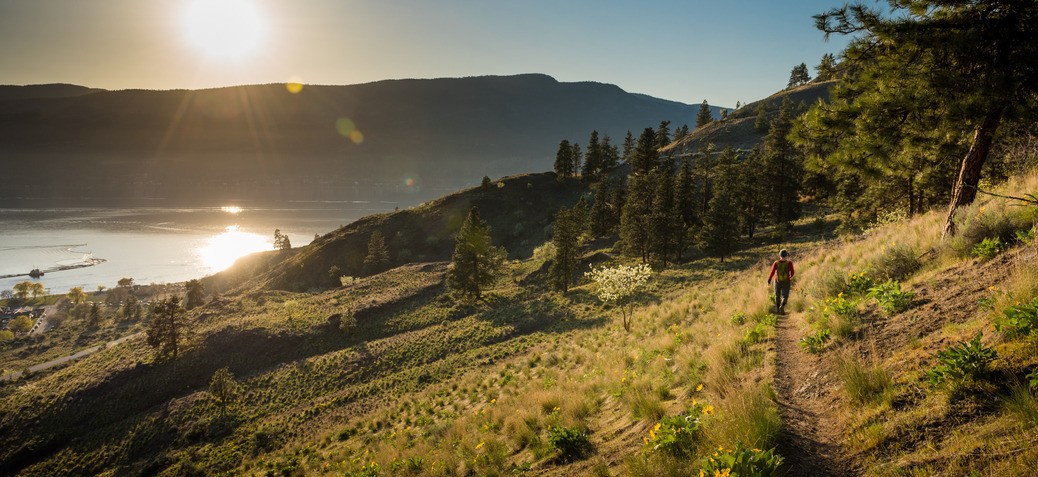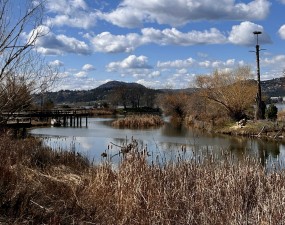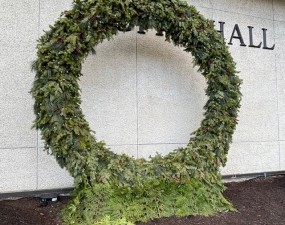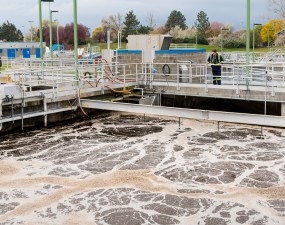Earth Day - Protecting our piece of paradise
Topics
Apr 21, 2022
Earth Day is important – it is a day for us to look at our actions, how they impact our planet, and what we can do to help mitigate and prepare for the impacts of climate change. Kelowna is one of the most naturally stunning places on Earth, and there is a lot at stake if we don’t work together to protect it.
Acting on climate change can feel overwhelming, but it doesn’t have to! There’s a lot you can do at home to reduce your environmental footprint by reducing emissions and preparing for local climate impacts like wildfires, extreme heat, and flooding. The City of Kelowna is also doing its part through various initiatives to address the current climate crisis.
What You Can Do
We all wonder how we can reduce our footprint to make a lasting difference. If we take little steps to change our behaviours, we make a big step in lessening our environmental footprint. Here are a few ideas:
Be WaterSmart
The Okanagan has one of the highest rates of water use per person in Canada, and hotter temperatures and droughts from climate change are only compounding the problem. When watering your yard, consider how much your plant and grass materials really need and water accordingly. When landscaping, use drought tolerant plants and shrubs that need little water; plus, they add curb appeal! The City can help by providing a free irrigation assessment. Simply contact our Water Smart program at [email protected] or visit our website to get your assessment and to start making water smart choices today.
Reduce. Reuse. Recycle.
This may seem cliché, but the “three Rs” are some of the most effective ways to reduce our environmental footprint and can help extend the life of the Glenmore Landfill! First focus on ways to reduce the amount of waste that goes into the trash can (e.g., backyard composting, buy and use less stuff). With what’s left, look for ways to reuse products (e.g., old clothes go to a thrift store) or make sure it goes in the appropriate recycling receptacle. Residents have many options available to recycle many items, check out the RDCO’s information on recycling.
Decarbonize your commute
Transportation is the largest source of greenhouse gas emissions in Kelowna. So, decarbonizing the way you move around town is an impactful way to reduce your household emissions. While electric vehicles are a great option, consider active transportation options like walking or riding your bike, e-bike, or scooter. Alternatively, take the bus or look at ridesharing options. Better yet, eliminate your commute completely by working from home even one or two days a week.
Decarbonize home energy use
Next to transportation, the energy used in our homes is the second largest source of emissions locally. Every home is different, and there are many ways to reduce your home’s emissions and save money on energy. You can start small with sealing air gaps, upgrading the thermostat, and switching all lighting to LED. For the bigger stuff, treat replacement cycles or major renovations as an opportunity to incorporate “greener” options. For example, if you’re renovating a bedroom for aesthetic purposes, use this as a chance to add more or better insulation or higher quality windows. If it’s time to replace your roof, take the opportunity to upgrade the attic insulation.
FireSmartTM your home
Wildfires are a natural component of our ecosystem but are becoming more significant with climate change. We need to prepare our communities to ensure they are resilient and protected. The best way to protect homes is to follow FireSmartTM guidelines. Look at removing debris from your roof, keep gutters clean, use fire resistant siding and fire-resistant windows and cut landscaping/vegetation at least 1.5 m from the house. Take advantage of the new Community Chipping Program to assist with hazardous landscaping removal.
Want to go the extra (low carbon) mile?
Here’s some other ways to reduce your footprint:
Don’t idle! The more fuel you use‚ the more emissions you produce. And one easy way to cut fuel consumption is to avoid unnecessary idling.
Keep our streams and Okanagan Lake healthy. Clean up garbage and watch what you put in storm water drains., as everything in the storm drains goes straight into Okanagan Lake. Our Adopt-a-Stream Program and Yellow Fish Road Program can help you demonstrate your commitment to healthy waterways.
Reduce single-use plastics. Don’t take a plastic bag if you don’t need to and be conscious of take-out containers. Styrofoam cups and containers, and plastic straws and cutlery unnecessarily end up in our landfill.
While there are many environmental champions, it’s important to acknowledge this year’s nominees for the Champion of the Environment Award as part of the 47th Annual Civic & Community Awards. Congratulations to Don Dobson, Karla Lockwood, and UBC Okanagan for your outstanding leadership!
What the City is Doing
At the City of Kelowna, we recognize we have a leadership role in climate action and environmental protection efforts. Below are some examples of how the City is leading the way and supporting residents in fighting the climate crisis.
Energy Studies
In 2021, facility energy studies were completed at the Rutland Family-Y, H2O Adventure + Fitness Centre, and City Hall. These studies identified measures that, if implemented, would reduce greenhouse gas (GHG) emissions by approximately 730 tonnes.
Green Fleet Strategy
Our new Green Fleet Strategy builds upon important efforts over the last 10 years to help meet the City’s corporate and community GHG emissions reduction goals and to lower GHG emissions from the corporate fleet. This strategy will help achieve 2023 zero-emission vehicle (ZEV) targets and build out an implementation plan for the next five and 10 years.
BC Energy Step Code
We are early adopters of BC Energy Step Code, which is an energy efficiency standard for new construction that local governments can opt-in to. Effective June 1, 2021, all Part 9 residential houses and small buildings must build to minimum Step 3 of the Energy Step Code (Energy Star, built Green Gold and Platinum) equivalent to 20% more efficient than the base BC Building Code. Effective January 1, 2022, all Part 3 large and complex buildings must meet or exceed Step Code requirements set out in the Implementation Strategy.
Electric Vehicle (EV) Charger Rebates
For a limited time, the City is offering an additional rebate to the CleanBC Go Electric Rebate Program for EV chargers for multi-unit residential buildings.
Heat Pump Rebates
Currently, additional rebates to the CleanBC Better Homes Program are offered through the City for residents who switch from a fossil fuel heating system to an electric air source heat pump.
Climate Modelling
Kelowna’s current Community Climate Action Plan outlines GHG emissions reduction actions until 2023, we are working on a project to understand the type of actions we would have to take to achieve the GHG reduction targets recommended by the Intergovernmental Panel on Climate Change (IPCC).
Wildfire Resilience
Our Urban Forestry branch is developing an updated Community Wildfire Resilience Plan, to better understand our wildfire risk, and to provide recommendations for reducing risk where possible. The new resiliency format includes a stronger focus on FireSmartTM initiatives, as well as improved collaboration between nearby communities.
Natural Assets
In 2021, Kelowna was one of 30 local governments from across Canada to take part in the Municipal Natural Assets Initiative (MNAI) Inventory Project. Establishing an inventory of natural assets is a key first step in understanding the services they provide to the community and the risks they face. In 2022, we’ve partnered with MNAI and RDCO once again to focus on incorporating ecosystems and species at risk as well as critical habitat into our inventory.
Low-Carbon Mobility
Kelowna’s new 2040 Transportation Master Plan sets ambitious, yet achievable targets for 2040, including doubling transit ridership, quadrupling the number of trips made by bicycle, and reducing the average distance each person drives by 20 per cent. Anyone can learn more about getting around Kelowna in earth-friendly ways by choosing active transportation.
Flood Protection
The Mill Creek Flood Protection Project is a multi-year, multi-million-dollar initiative to improve the creek corridor and reduce flooding potential from the airport to Okanagan Lake. As part of that project, improvements are being made to the diversion structure located next to the Okanagan Rail Trail east of Dilworth Drive and will include hydraulic and trash management improvements.
For a more comprehensive list of our recent environmental initiatives, check out the progress update on the Environmental Protection Council Priority.
The Earth and its atmosphere are changing, and our behaviors need to too. The little changes we take every day makes a big impact overall. We can do this – together.







